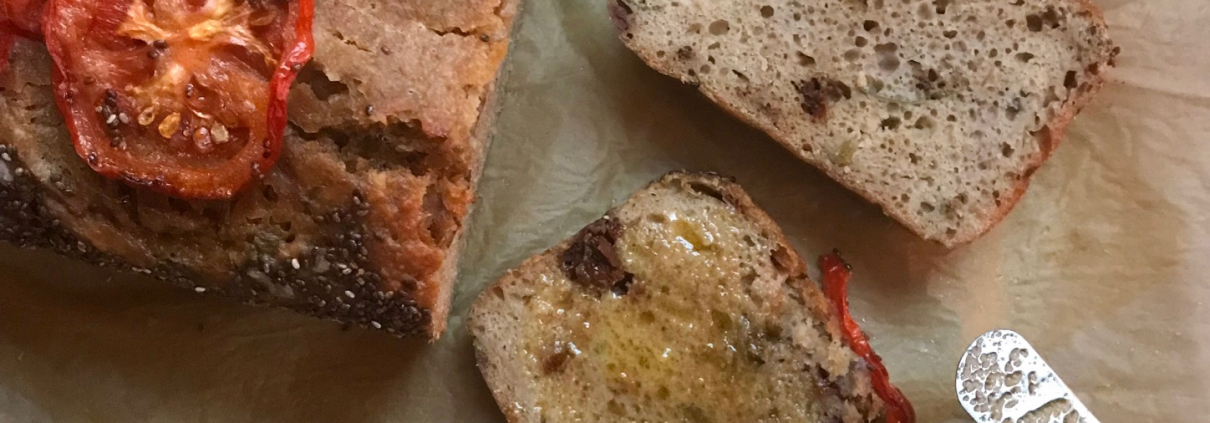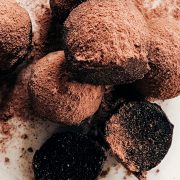Fermented Whole Spelt + Khorasan Bread
This bread is without a doubt a staple on my catering and private menus and in my house – it’s easy, it’s fermented and it has so many options for infusing with flavours and swapping out grains. Often I find that people with gluten intolerance (not allergy) usually find they can eat this.
You can put this recipe into one loaf pan or 3 mini loaf pans. Perfect.
My favourite mix of grains is either Wholemeal Spelt + Khorasan (also known as Kamut* ) or Wholemeal Spelt + Rye.
Here I have put parsley stalks, leaves + macerated sun-dried tomatoes through the loaf and topped it with tomato + chia but the options are endless.
Some great infusions through the bread would be:
– loads of fresh Rosemary + Thyme
– Olive tapenade paste
– Slow roasted garlic
– Grated carrot
– Diced Parmesan Cheese Caramlised Onion
You just fold through the additions from beginning unless they are an ingredient that will spoil, in that case fold through before adding to the pan.
Read through the recipe a few times it looks like a lot but it isn’t, for new bakers it’s always a good idea to read through and get yourself set up before you start.
The Goodness:
260 g Wholemeal Spelt
260 g Khorasan
1 tsp Sea Salt
1 tsp Coconut Sugar or Rapadura or Raw Sugar – do not omit
1 tsp Yeast I use powdered for ease
approx 2-3 cups of filtered water
Making the Goodness:
- Weigh up the flours, add the salt and whisk together.
Now to the only tricky part and it is important –
- In a plastic or glass bowl add the yeast and sugar and 1/2 cup of cold water, mix and then add up to another 1/2 cup or so of boiling water ensuring the water does not end up much more than just above lukewarm to touch
- conversely you can make up a 50/50 mix of water in another bowl until you get the desired temp – too hot it will kill the yeast – too cold it will not start the yeast – and then add that to the yeast and sugar totalling 1 cup.
- I have a lamp in my kitchen and I place it under that and it starts to bloom and froth and is ready in about 10 minutes, if it is warm in your kitchen that helps. I have found the 1 cup method works well to start the yeast, I actually do the mixing in a 1 cup measuring cup – and then add that to the dough see this photo, this is what you are aiming for.
- You could also turn your oven on low as possible and place the bowl in the oven with the door open to activate the yeast
- Once bloomed add to the flours and then keep adding water until the dough starts to come together – this will differ depending on your grains. Mixing with a silicone spatula, scraping the sides and working the dough a little, this is a wet dough. You can add a little more flour and start to knead on the bench too, but the no knead option works beautifully too.
- Once the dough is wet and your herbs etc are mixed through place in a lightly oiled stainless or glass bowl and seal with cling film – you want the dough to ferment and be sealed in., This can continue for up to 36 hours or for as little as overnight. I find 24 hours is great, this photo is before I have covered it.
- After at least 12 hours though 24hours or so is great, bring the mix together with your spatula and spoon into a parchment lined loaf pan, sprinkle and garnish as desired or not, and if the dough is light and well fermented you can put straight into a cold oven and turn it up to 160C convection and bake for 50 – 65 mins checking at 50mins. If it feels light and springy it is done.
- If you didn’t do the long ferment you may need to let the dough rise again in the pan before cooking, to expedite this put in the cold oven with the light on. Once it is close to about an inch or more from rim of pan you are good to go. Same temps and same time for baking.
- Once the bread is done, remove from the pan with the parchment paper and then remove from parchment paper to a cookie airing rack or the bread will sweat.
- Let cool before cutting and then drizzle or dip as desired, I drizzled freshly made ghee onto this loaf and it was sublime.
Enjoy, if you make this and share on social media or on your blog, please be sure to tag in @nourishedandnurtured thank you!
* Khorasan wheat, like emmer/farro, einkorn, and spelt, is an ancient variety of wheat meaning that it has been largely unchanged by breeding over the last several hundred years.
It has a sweet, nutty, buttery flavor and some consumers who thought they were sensitive to modern wheat report that this ancient wheat variety seems easier to digest, causing less gastrointestinal distress or inflammation than they typically experience with the non ancient strains of wheat products.
I use Khorasan from Demeter Farm Mill in Australia as that is stocked by my supplier, in the USA Bob’s Red Mill is an excellent choice both working with traditional milling practices.







